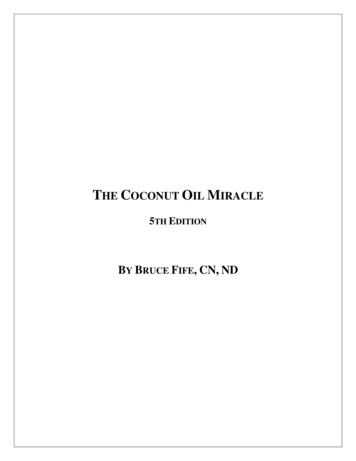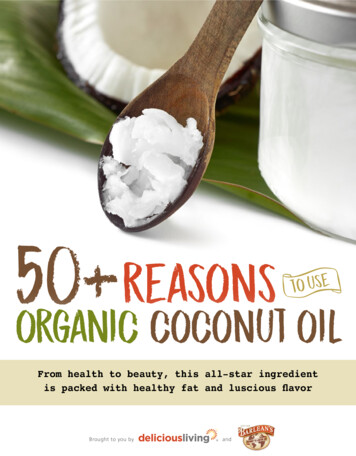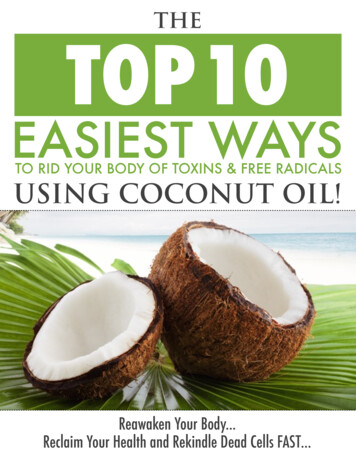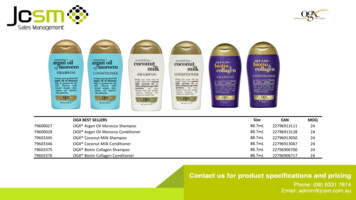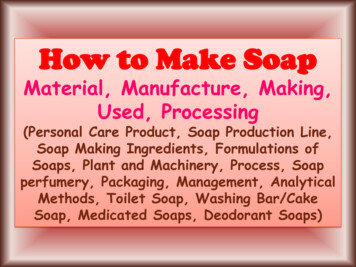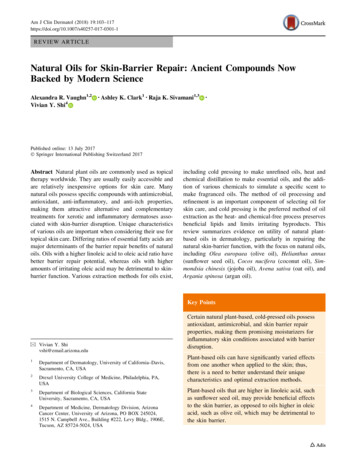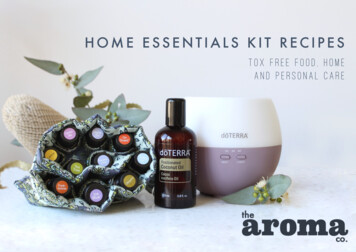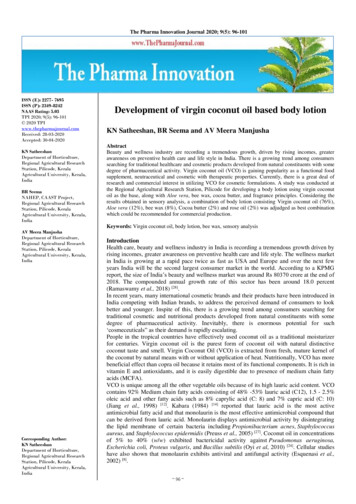
Transcription
The Pharma Innovation Journal 2020; 9(5): 96-101ISSN (E): 2277- 7695ISSN (P): 2349-8242NAAS Rating: 5.03TPI 2020; 9(5): 96-101 2020 TPIwww.thepharmajournal.comReceived: 28-03-2020Accepted: 30-04-2020KN SatheeshanDepartment of Horticulture,Regional Agricultural ResearchStation, Pilicode, KeralaAgricultural University, Kerala,IndiaBR SeemaNAHEP, CAAST Project,Regional Agricultural ResearchStation, Pilicode, KeralaAgricultural University, Kerala,IndiaAV Meera ManjushaDepartment of Horticulture,Regional Agricultural ResearchStation, Pilicode, KeralaAgricultural University, Kerala,IndiaCorresponding Author:KN SatheeshanDepartment of Horticulture,Regional Agricultural ResearchStation, Pilicode, KeralaAgricultural University, Kerala,IndiaDevelopment of virgin coconut oil based body lotionKN Satheeshan, BR Seema and AV Meera ManjushaAbstractBeauty and wellness industry are recording a tremendous growth, driven by rising incomes, greaterawareness on preventive health care and life style in India. There is a growing trend among consumerssearching for traditional healthcare and cosmetic products developed from natural constituents with somedegree of pharmaceutical activity. Virgin coconut oil (VCO) is gaining popularity as a functional foodsupplement, neutraceutical and cosmetic with therapeutic properties. Currently, there is a great deal ofresearch and commercial interest in utilizing VCO for cosmetic formulations. A study was conducted atthe Regional Agricultural Research Station, Pilicode for developing a body lotion using virgin coconutoil as the base, along with Aloe vera, bee wax, cocoa butter, and fragrance principles. Considering theresults obtained in sensory analysis, a combination of body lotion consisting Virgin coconut oil (76%),Aloe vera (12%), bee wax (8%), Cocoa butter (2%) and rose oil (2%) was adjudged as best combinationwhich could be recommended for commercial production.Keywords: Virgin coconut oil, body lotion, bee wax, sensory analysisIntroductionHealth care, beauty and wellness industry in India is recording a tremendous growth driven byrising incomes, greater awareness on preventive health care and life style. The wellness marketin India is growing at a rapid pace twice as fast as USA and Europe and over the next fewyears India will be the second largest consumer market in the world. According to a KPMGreport, the size of India’s beauty and wellness market was around Rs 80370 crore at the end of2018. The compounded annual growth rate of this sector has been around 18.0 percent(Ramaswamy et al., 2018) [28].In recent years, many international cosmetic brands and their products have been introduced inIndia competing with Indian brands, to address the perceived demand of consumers to lookbetter and younger. Inspite of this, there is a growing trend among consumers searching fortraditional cosmetic and nutritional products developed from natural constituents with somedegree of pharmaceutical activity. Inevitably, there is enormous potential for such‘cosmeceuticals” as their demand is rapidly escalating.People in the tropical countries have effectively used coconut oil as a traditional moisturizerfor centuries. Virgin coconut oil is the purest form of coconut oil with natural distinctivecoconut taste and smell. Virgin Coconut Oil (VCO) is extracted from fresh, mature kernel ofthe coconut by natural means with or without application of heat. Nutritionally, VCO has morebeneficial effect than copra oil because it retains most of its functional components. It is rich invitamin E and antioxidants, and it is easily digestible due to presence of medium chain fattyacids (MCFA).VCO is unique among all the other vegetable oils because of its high lauric acid content. VCOcontains 92% Medium chain fatty acids consisting of 48% -53% lauric acid (C12), 1.5 - 2.5%oleic acid and other fatty acids such as 8% caprylic acid (C: 8) and 7% capric acid (C: 10)(Jiang et al., 1998) [12]. Kabara (1984) [14] reported that lauric acid is the most activeantimicrobial fatty acid and that monolaurin is the most effective antimicrobial compound thatcan be derived from lauric acid. Monolaurin displays antimicrobial activity by disintegratingthe lipid membrane of certain bacteria including Propionibacterium acnes, Staphylococcusaureus, and Staphylococcus epidermidis (Preuss et al., 2005) [27]. Coconut oil in concentrationsof 5% to 40% (w/w) exhibited bactericidal activity against Pseudomonas aeruginosa,Escherichia coli, Proteus vulgaris, and Bacillus subtilis (Oyi et al, 2010) [24]. Cellular studieshave also shown that monolaurin exhibits antiviral and antifungal activity (Esquenasi et al.,2002) [8]. 96
The Pharma Innovation Journalhttp://www.thepharmajournal.comUsually, mineral oil is the major ingredient for preparation ofmoisturizers (Pandiselvam et al., 2019) [25]. Unlike mineraloil, fatty acids present in the coconut (particularly lauric acid)have been found to have antiseptic properties (Kumar et al.,2018) [17] and is more efficient and safe. A natural moisturizerwith antiseptic effects has higher consumer appeal in themarket. So VCO can be viewed as an ingenious and safereplacement for mineral and petroleum based emollientsbecause of its appreciable contents of skin active ingredients.Anti-ageing properties of VCO are closely related to presenceof high amount of antioxidants present in it. The rich VitaminE content in it prevents premature aging and maintains thevitality of the body. When VCO is used as a base in topicalapplications such as cream or lotion it can perform antiageing functions.VCO is one of the natural skin moisturizers which can preventtissue damage and provide protection to the skin. VCO doesnot cause skin irritation and can be applied even to the mostsensitive skin. Clinical studies have revealed that VCO iseffective and safe to use as a moisturizer and can improveskin hydration and accelerate healing in the skin. It reducesskin disorders by moisturizing and soothing the skin (Sahle, etal 2015) [30]. Hence, one of the major applications of VCO isin the formulation of hypoallergenic cosmetics and skin careproducts (Agero and Verallo-Rowell, 2005) [1].VCO is the best possible remedy to various skin ailments. Thepresence of fatty acids (especially lauric and oleic acid) inVCO softens the skin enhancing penetration potential (Kanget al., 2006) [15]. The emollient effect of Virgin coconut oilhas been successfully demonstrated in atopic dermatitispatients, thereby showing that coconut oil is a potent naturalemollient to be used in treatment of xerosis. In a studyconducted by Aziz et al. (2013) [3] to compare the differencebetween body lotion containing VCO-Solid lipid particles(SLPs) and lotion without VCO-SLPs, it was concluded thatmoisturizing lotion incorporated with VCO-SLPs was foundto increase skin hydration and skin elasticity by 24.8% and2.60% respectively from day 0 to day 28. VCO is the bestskin care choice especially for babies, because it is naturaland free from all chemical formulations and assures goodprotection to the baby skin. In a clinical trial with pediatricpatients having mild to moderate atopic dermatitis, topicalapplication of VCO for eight weeks was superior to that ofmineral oil (Evangelista et al., 2014) [9]. This shows that VCOsolid lipid particles have the potential to be utilized as acarrier for improved dermal delivery of body lotions.Therefore, VCO could be useful in treating skin disorderswith permeability barrier dysfunction, especially thoseaccompanied by reduced epidermal protein expression, suchas atopic dermatitis and eczema.Topical application of virgin coconut oil also protects the skinfrom UV radiation. Varma et al. (2019) [38] evaluated theeffect of VCO on skin hydration and barrier function on UVprotection potential of VCO. The results indicated the antiinflammatory activity of VCO by suppressing inflammatorymarkers and protecting the skin by enhancing skin barrierfunction. The study concluded that topical application ofVCO bring anti inflammatory activity and improves skinbarrier function by protecting against Ultra Violet Birradiation. The results warrant the use of VCO in sun screenskin care formulations.There are several indigenous plant-based fats and oils or theirderivatives with interesting bioactive properties that areincreasingly recognized for their effects on both skin care andthe restoration of cutaneous homeostasis. Preparations fortopical applications combining plant oils and bio activecompounds may have a complimentary effect on the skinaccording to their composition and constituents. Whenapplied topically, constituents of plant oils (triglycerides,FFAs, phenolic compounds and antioxidants) may actsynergistically by several mechanisms:I. promoting skin barrier homeostasis;II. anti-oxidative activities;III. anti-inflammatory properties;IV. anti-microbial properties;V. promoting wound healing;VI. anti-carcinogenic properties (Lin et al., 2015).Literature survey reveals the potential for supplemental use ofcertain important bioactive compounds from plants along withVCO for their antimicrobial and anti-inflammatory activity, incurative and protective topical formulations. A combinationof such constituents from plants with high percentage oftocopherols, phytosterols and triterpenes significantly reducewrinkles and roughness of the skin (Mandawgade andVandana, 2008) [21]. Moisturizing creams and lotions withVCO as base and containing such biocompatible compoundshave high oxidative resistance. There is enough potential todevelop skin care products using these plant-basedcompounds for dermatological treatments. Adding attractiveor therapeutic fragrances either through the use of essentialoils or by oil infusion will enhance its marketability as a skinconditioner.Aloe vera is one of the richest natural sources of medicinalprinciples widely used in Ayurvedic, Homoeopathic andAllopathic streams of medicine (Serrano et al., 2006).Traditionally, Aloe vera gel is used both topically as a skintonic, and internally to treat various ailments such asconstipation, ulcers, coughs, diabetes, arthritis, immunesystem deficiencies and urinary complaints (Pathak andSharma, 2017) [26]. Aloe vera leaf gel contains more than 200different biologically active compounds including Sterols,proteins, lignin, polysaccharides, vitamins, minerals,enzymes, amino acids, anthraquinones and saponins havingemollient, anti inflammatory, antioxidant, antiseptic andanticancer properties (Mahor and Ali, 2016, Pathak andSharma, 2017) [19, 26]. Presence of minerals like calcium,magnesium, zinc, vitamins like A, B12, C, E and essentialfatty acids make it a miracle beauty herb and an importantcomponent of cosmetics and skin care products.The Aloe gel also acts as a moisturizing agent and gives acooling effect to the skin. Empirical evidences validate thequality of this plant as a skin tonic and its potential to treatskin diseases. In clinical studies for treatment of dry skinassociated with occupational exposure, Aloe vera gelimproved the skin integrity, decreased appearance of finewrinkle and erythema (West and Zhu, 2003) [39]. The antiinflammatory activity of Aloe vera gel has been revealed in anumber of studies through bradykinase activity (Che et al,1991) [7]. Topical application of the gel keeps the skin moistin harsh and dry weather and prevents forming flaky scalp andskin (Barcroft et al., 2003) [4]. Mucopolysaccharides presentin it help in binding moisture into the skin and softens it(Surjushe et al. 2008) [36]Aloe vera is useful for the healing of first to second degreeburns and wounds (Maenthaisong et al. 2007) [18]. Sahu et al.,(2013) [31] has reported that the external use of this herbprevents injury of epithelial tissues, accelerates wound 97
The Pharma Innovation Journalhttp://www.thepharmajournal.comhealing, cures acne and gives a youthful glow to skin andprimarily acts as skin healer. It also has role in gerontologyand rejuvenation of aging skin.Due to antibacterial and antifungal properties, Aloe veraextracts are helpful in the treatment of minor skin infections.It is cable of inhibiting the growth of fungi that cause tineaand is useful in the treatment of boils and benign skin cysts(Shamim et al., 2004) [34]. A processed Aloe vera gelpreparation inhibited the growth of fungus Candida albicansand the inhibitory effect varied with concentration (Shireen etal., 2015) [35]. Aloe vera gel can be used as an effectiveantibacterial agent in order to prevent wound infection causedby Pseuodomonas aeruginosa (Goudarzi et al., 2015) [11].Antiseptic properties are due to presence of phenols, lupeol,sulphur, salicylic acid, urea nitrogen and cinnamic acid in theleaf gel which have inhibitory action on fungi, bacteria andviruses, Hence addition of Aloe vera to the cosmetic boostsantiseptic property.The presence of a mixture of glucosides in the leaves of Aloevera collectively known as aloin is the active constituentwhich is responsible for the skin healing properties (Mahorand Ali, 2016) [19]. Aloin and its gel are effective in curingpimples and rejuvenation of aging skin (Joseph and Raj,2010) [13]. Aloe vera gel has an antioxidant protein,metallothionein, which scavenges hydroxyl radicals andsuppress skin burn effect in radiation dermatitis. Use of Aloevera gel have a positive effect on reduction of radiationtherapy induced skin reactions and its symptoms and haveprotective effect against radiation damage to the skin (Marsy,2013). It protects the skin from UV-induced suppression ofdelayed type hypersensitivity, (Byeon et al., 1988) [6] and hasbeen scientifically proven remedy for thermal, or solarradiation (Korac and Khambolja, 2011) [16] and hence can beincluded in sun screen lotion.There are a number of cosmetic products in the market inwhich Aloe vera is a major constituent. Aloe vera gel, creamor lotion applied on the face forms a delicious cover that helpsto shield the skin from dust and other elements injurious tothe skin (Rawlings and Harding, 2004) [29]. Combined withother functional compounds and selected essential oils forfragrance, it makes an excellent product that may be usedpost-showering to obtain the skin in super soft shape. Due toits soothing and cooling qualities, it is suitable for formulatinga whole range of beauty products.Cocoa butter is the byproduct of cocoa bean processingindustry and is obtained from the mature beans of Theobromacacao pods. Cocoa butter contains a high proportion ofsaturated fat, palmitic acid and trace amounts of caffeine andtheobromine. It also contains fat soluble antioxidants such asvitamin E in the form of β-tocopherol, α-tocopherol and γtocopherol and helps in its storage and impart an anti-ageingeffect. Cocoa butter enjoys a reputation as one of the best skinmoisturizers in the market. Its rich texture and highconcentration of oleic acid make it a popular body moisturizer(Sethi et al., 2016) [33]. Due to its moisturizing and antioxidantproperties, cocoa butter is widely used in the formulations ofcosmetics and soaps (Nayak and Kumar, 2014) [23].Beeswax is a natural compound secreted by bees and iswidely used as a supportive ingredient in cosmetic andpharmaceutical formulation. Since ancient times, the basicrecipe for creams and ointments consisted of a mixture ofbeeswax and oil in various proportions according to thedesired consistency. Beeswax is mainly composed of amixture of hydrocarbons, free fatty acids, monoesters,diesters, triesters, hydroxy monoesters, hydroxy polyesters,fatty acid polyesters, and some unidentified compounds (Maiaand Nunes, 2013) [20]. These natural ingredients help retainmoisture in the skin and reduce dryness.Beeswax also contains small amounts of natural antibacterialagents and can help prevent a painful inflammation thatcomes with an infection. Beeswax is vitamin-rich, containingplenty of vitamin A, which helps to improve wound healing,reduces wrinkles, protects the skin against UV radiation, andstimulates skin cells turnover (Fratini et al., 2016) [10]. Beeswax has anti-inflammatory and healing properties, which isone of the reasons why it is widely used in cosmetic andpharmaceutical products (Al-Waili, 2003., Fratini et al., 2016)[2, 10]. Beeswax has an irritation potential of zero, and acomedogenicity rating of 0 – 2. This means that whenbeeswax is used in cosmetic formulations in correctproportions, it will facilitate general healing and softening,and will add antiseptic and emollient properties to thecosmetic product and will not cause clogging of the pores(Bogdanov, 2011) [5].Increasing health consciousness of people and consumerspending on cosmetic products made of natural substances oringredients for proper nourishment of skin and hair isanticipated to propel the demand for virgin coconut oil basedhealth care products. Emulsions and lotions offer theresearcher a great degree of formulation flexibility inmodification of characteristics such as viscosity, feel andappearance. Lotions allow otherwise incompatible ingredientssuch as butters, oils, fats and fragrance to be brought togetherin the same product to be applied to the skin in anaesthetically pleasing fashion. Body lotion prepared usingnatural raw materials like virgin coconut oil as base with acombination of bee wax, cocoa butter, Aloe vera and otheringredients can achieve these objectives. By combining theseingredients we can develop an excellent lotion which will be agreat natural skincare product that will be beneficial for theconsumers. Keeping these points in view, the present studywas undertaken to develop virgin coconut oil based bodylotion at the NAHEP- CAAST project centre of RegionalAgricultural Research Station, Kerala Agricultural University,Pilicode, Kasaragod district, Kerala, India.Materials and MethodsThe purpose of this study was to determine the idealcombination of constituents and their proportion in theformulation for development of a natural body lotion. The rawmaterials selected for development of body lotion consists ofVirgin coconut oil, Aloe vera, Bee wax, cocoa butter, andfragrance principles. The fragrance principles tried in thecombinations are essential oils from rose, lavender andpeppermint. Among the raw materials, VCO was collectedfrom the centre of excellence in value addition, RARSPilicode, Kasaragod. Aloe vera was collected from RARSfarms. Bee wax was procured from local bee keeping farmers.Cocoa butter was collected from Cocoa Research Centre,Kerala Agricultural University, Vellanikkara, Thrissur.Essential oils like rose, lavender and peppermint oil werecollected from M/S Synthite industries Pvt. Ltd. Kolenchery,Kochi., Kerala.Combination of ingredients for body lotionThe ingredients used for body lotion are blended in differentcombinations and proportions. Various ingredients used forbody lotion and their formulations tried are provided inTable1. 98
The Pharma Innovation Journalhttp://www.thepharmajournal.comTable 1: Ingredients used in body lotion blend and formulationsSl. No.IngredientsAbbreviation12345Virgin coconut oilAloe veraBeeswaxCocoa butterFragranceOABCFBody lotion was prepared in 6 Combinations. VCO levelstried were 66, 68, 70, 72, 74 and 76 percentage. Thefragrances included in the trial were F1: Lavender oil, F2:T166218122Formulation (%)T2 T3 T4 T5 T668 70 72 74 764 6 8 10 1216 14 12 10 810 8 6 4 22 2 2 2 2Peppermint oil, and F3: Rose oil (as shown in Table 2.) with auniform 2 percent in all the treatment combinations.Table 2: Combination treatments for body lotionCombinationsT1T2T3T4T5T6VCO Aloe vera oa butter(C)12108642Fragrance (F)F1 F2 F3222222for cooling for about 15-20 min. When it is cool, add Aloevera and whip it well (using electronic hand beater) till itbecomes light and fluffy. Add few drops of essential oil(rose/lavender/peppermint oil) to the resultant lotion. At lastgive a final mix and body lotion is ready. Fill in transparentcontainers.Preparation procedureFlow chart for preparation of body lotion is provided in Fig 1.Place bee wax and cocoa butter in a bowl. Bee wax and cocobutter are melt in a stainless-steel vessel adopting doubleboiling method. When it melts, virgin coconut oil is added tothe mixture and melt it further. This molten mixture isstrained using muslin cloth still when it is warm and keep itFig 1: Flow chart for preparation of body lotionwhite in colour and their texture differ from thick to softbased on the combination percentages of the ingredients.Their fragrance also varied according to the essential oilsadded. The overall appearance was homogenous in nature forall formulations with no visible spots.The treatments were subjected to sensory analysis forconsumer’s acceptance. The quality and acceptability of bodylotion was judged by a consumer panel team consisting oftwelve semi-trained members. The sensory evaluation of theproduct was performed based on a nine-point hedonic scalefor colour, appearance, fragrance, texture and overallacceptability of the developed samples. The result revealedthat there were significant differences among the treatmentcombinations for the organoleptic qualities. Overallacceptability of body lotion varied from 6.83 to 7.98. AnalysisSensory evaluationThe prepared body lotion samples were evaluated for sensorycharacteristics. A semi-trained panel of 12 judges evaluatedthe prepared products for colour, appearance, fragrance,texture and overall acceptability on a 9-point hedonic scale.Statistical analysisFactorial completely randomised design (FCRD) was adoptedfor analyzing the data by using Design-Expert software.Statistical significance was examined by analysis of variance(ANOVA) for each response.Results and DiscussionDifferent formulations of the body lotion were prepared as perthe procedure laid out in the flow chart and all of them are 99
The Pharma Innovation Journalhttp://www.thepharmajournal.comof variance reveals that the overall acceptability of varioussamples was significant (p 0.0001).The average scores of body lotion for each parameter weregiven in Table 3. The best treatment selected by sensory panelwas T6 with an overall acceptability of 7.98 having acombination of O76: A12: B8: C2: F(3)2 i.e., Virgin coconut oil(76%), Aloe vera (12%), Bee wax (8%), Cocoa butter (2%)and rose oil (2%).Table 3: Sensory analysis of body ts were made to develop a product which would havehighest score in sensory acceptability so as to get a bettermarket acceptability, Under these criteria, T6 i.e., Virgincoconut oil: Aloe vera: cocoa butter: Bee wax: virgin coconutoil: Cocoa butter: rose oil in the ratios of 76:12:8:2:2 wasfound as optimum (Fig 2). The response was predicted by theDesign-Expert 7.0.0 software. Based on optimization andsensory evaluation, T6 sample is selected as a bestcombination out of all combinations under concern. Theprepared lotion formulations were light, non-greasy and liquiddosage form and appears as soft, free flowing with uniformconsistency and adhere over the skin as a film. Developedbody lotion does not show any sedimentation stored at theroom temperature up to three months and has good stability.Skin contamination is one of the most probable risks withpotential health consequences for the people havingoccupational exposure to various hazards. Many of the skincare products that are available in the market based onchemical formulations are harsh and irritating, even toxicwhich underlines the need to identify and develop a researchprotocol for natural products. In this context, the topical bodylotion formulation developed in this study assumessignificance in reducing the danger of human health risk andpolluting the environment. Virgin coconut oil whichconstitutes a major proportion of the formulation itself acts asa preservative increasing the shelf-life of body lotion andprevents it from microbial degradation. The body lotiondeveloped is free from skin irritancy, has long self-life and isquiet stable and safe.Fig 2: Sensory scores of body 7.246.776.836.417.76Overall Acceptability6.886.837.216.927.167.98natural body lotion employing VCO and the ingredientsmentioned could be applied in industrial scale and adopted formass production.Reference1. Agero AL, Verallo-Rowell VM. A randomized doubleblind controlled trial comparing extra virgin coconut oilwith mineral oil as a moisturizer for mild to moderatexerosis. Dermatitis 2005; 15(3):109-116.2. Al-Waili NS. Topical application of natural bee wax andolive oil mixture for atopic dermatitis or Complementary Therapies in Medicine. 2003; 11(4):226234.3. Aziz A, Sarmidi M, Aziz R, Norhayati MN. The Effect ofVirgin Coconut Oil Loaded Solid Lipid Particles (VCOSLPs) on Skin Hydration and Skin Elasticity. JurnalTeknologi. 2013; 62:39-43.4. Barcroft A, Myskja A, Reinolds T. Properties ofStabilized Aloe vera. In: Barcroft, A., Myskja, A. andReinolds, T., Eds., Aloe vera: Nature’s Silent Healer,BAAM Publishing Ltd., London. 2003, 1-16.5. Bogdanov S. Functional and Biological Properties of theBee Products: a Review. Bee Product Science, 2011; 1:112. www.bee-hexagon.net.6. Byeon S, Pelley R, Ulrich SE, Waller TA, Bucana CD,Strickland FM. Aloe Barbadensis Extracts Reduce theProduction of Interleukin-10 after Exposure to UltravioletRadiation, Journal of Investigative Dermatology,1988;110:811-817.7. Che QM, Akao T, Hattori M, Kobashi K, Namba T.Isolation of Human Intestinal Bacteria Capable ofTransforming Barbaloin to Aloe-Emodin Anthrone,Planta Medica. 1991; 57(1):15-19.8. Esquenazi D, Wigg MD, Miranda MM, Rodrigues HM,Tostes JB, Rozental S et al. Antimicrobial and antiviralactivities of polyphenolics from Cocos nucifera Linn.(Palmae). Res. Microbiol. 2002; 153:647-652.9. Evangelista MTP, Flordeliz AC, Lillian Lopez V. Theeffect of topical virgin coconut oil on SCORAD index,trans-epidermal water loss, and skin capacitance in mildto moderate paediatric atopic dermatitis: a randomized,double‐ blind, clinical trial. International journal ofdermatology. 2014; 53(1):100-108.10. Fratini F, Cilia G, Turchi B, Felicioli A. Beeswax: Amini review of its antimicrobial activity and itsapplication in medicine. Asian Pacific Journal of TropicalMedicine. 2016; 9(9):839-843.11. Goudarzi M, Fazeli M, Azad M, Seyed Javadi SS,Mousavi R. Aloe vera Gel: Effective Therapeutic AgentIt can be concluded that one of the formulations of the lotionranked as excellent with a content of VCO at 76 percent alongwith other ingredients devoid of any preservatives isacceptable. This process technology and formulation for 100
The Pharma Innovation 6.27.28.http://www.thepharmajournal.comagainst Multidrug-Resistant Pseudomonas aeruginosaisolates Recovered from Burn Wound InfectionsChemother Res Pract. 639806. Published online 2015 Jul22. doi: 10.1155/2015/639806.Jiang WG, Bryce RP, Horrobin DF. Essential fatty acids:Molecular and cellular basis of their anti-cancer actionand clinical implications. Crit. Rev. Oncol. Hematol.,1998; 27:179-209.Joseph B, Raj SJ. “Pharmacognostic and Phyto-chemicalProperties of Aloe vera Linn -An Overview,”International Journal of Pharmaceutical Sciences Review& Research. 2010; 4(2):106-110.Kabara JJ. Antimicrobial agents derived from fatty acids.Fatty Chemical Applications and Analysis, American oilchemists Society. 1984; 61(2):397-403.Kang L, Ho PC, Chan SY. Interactions between a skinpenetration enhancer and the main components of humanstratum corneum lipids. J Therm. Anal. Calorim. 2006;83:27-30.Korać RR, Khambholja KM. Potential of herbs in skinprotection from ultraviolet radiation. Pharmacogn. Rev.2011; 5(10):164-173.Kumar GP, Lakshmi NVVSS, Deena C, Bhavani B,Kumar PR. Facts about Virgin Copra Oil: Chemistry,Production - A Review on Potential Applications andFunctional Properties. Haya: The Saudi Journal of LifeSciences, 2018, 624-633.Maenthaisong R, Chaiyakunapruk N, Niruntra S. TheEfficacy of Aloe vera for Burn Wound Healing: ASystematic Review. Burns. 2007; 33(6):713-718.Mahor G, Ali SA. Recent update on the medicinalproperties and use of Aloe vera in the treatment ofvarious ailments. Biosci. Biotech. Res. Comm. 2016;9(2):273-288.Maia M, Nunes FM. Authentication of beeswax (Apismellifera) by high-temperature gas chromatography andchemometricanalysis. FoodChemistry.2013;136(2):961–968.Mandawgade SD, Vandana BP. Formulation andEvaluation of Exotic Fat Based Cosmeceuticals for SkinRepair. Indian J Pharm Sci. 2008; 70(4):539-542.Weheida SM, Riad NA, Masry SE. The Effect of Skinpreparation by Using Aloe vera Gel on Incidence of SkinReactions among Breast Cancer Patients UndergoingRadiation Therapy. Biology, Agriculture and Healthcare,2013; 3(15):130-145.Nayak B, Kumar V. Cocoa Butter and Its Alternatives: AReview. Journal of Bioresource Engineering andTechnology. 2014; 1:7-17Oyi AR, Onaolapo J, Obi RC. Formulation andAntimicrobial Studies of Coconut (Cocos nucifera Linne)Oil. Res. J Appl. Sci. Eng. Technol., 2010; 2:133-137.Pandiselvam R, Ramarathinam M, Beegum S, MathewAC. Virgin Coconut Oil infused healthy cosmetics.Indian Coconut Journal. 2019; 13:30-32.Pathak D, Sharma R. Review On Aloe vera- MedicinalPlant. International Journal of Advance Research andInnovative Ideas in Education (IJARIIE), 2017; 3(1):661671.Preuss HG, Echard B, Enig M, Brook I, Elliott TB.Minimum inhibitory concentrations of herbal essentialoils and monolaurin for gram-positive and gram-negativebacteria. Mol. Cell. Biochem. 2005; 272:29-34.Ramaswamy N, Vilvarayanallur N, Kumar G. Human29.30.31.32.33.34.35.36.37.38.39. 101 resource and skill requirements in beauty and wellnesssector (2017-2022), KPMG, National skill developmentcorporation, Govt of India, 2018.Rawlings AV, Harding CR. Moisturization and sk
Virgin coconut oil is the purest form of coconut oil with natural distinctive coconut taste and smell. Virgin Coconut Oil (VCO) is extracted from fresh, mature kernel of . fatty acids make it a miracle beauty herb and an

